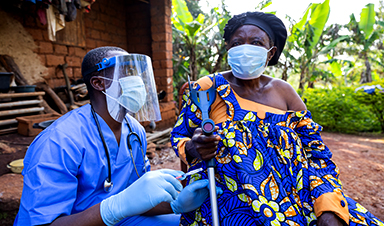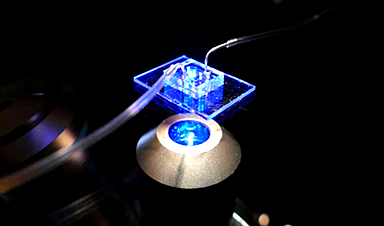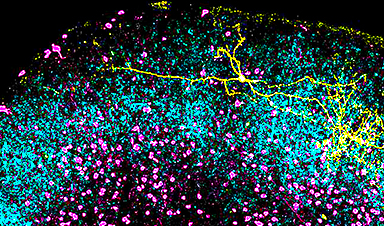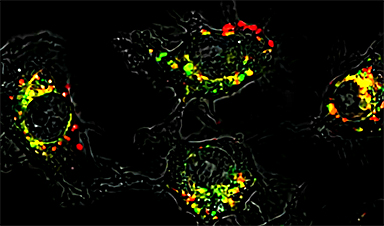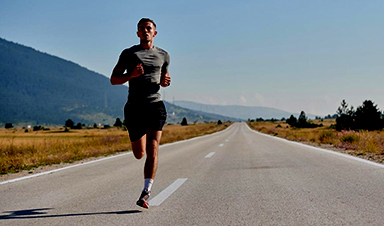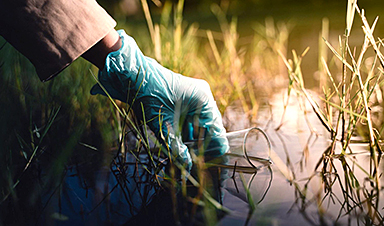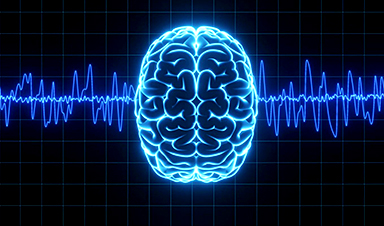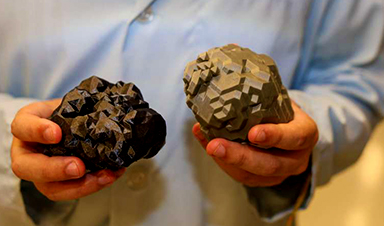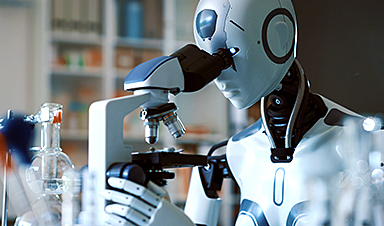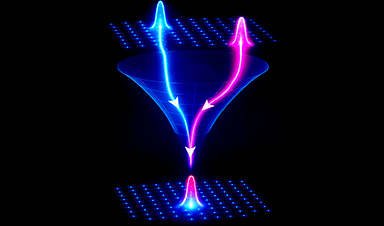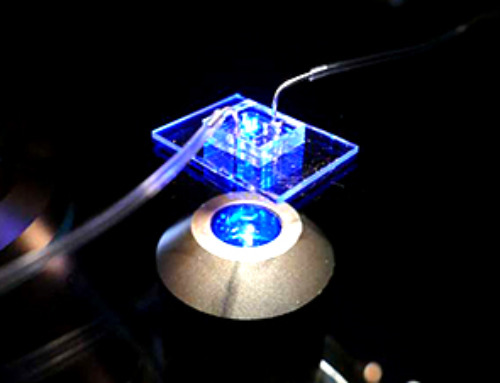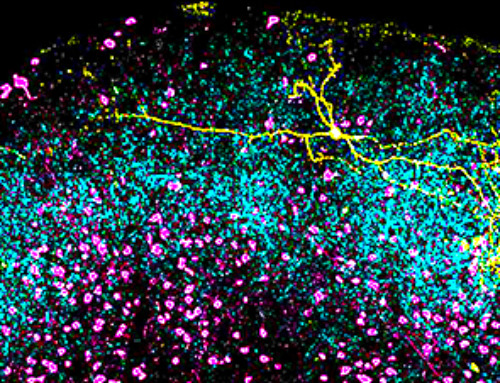New research led by scientists at La Jolla Institute for Immunology (LJI) reveals the workings of a human antibody called mAb 3A6, which may prove to be an important component for Ebola virus therapeutics.
This antibody was isolated from blood samples from an Ebola survivor treated at Emory University Hospital during the 2014-2016 Ebola virus outbreak, an outbreak that began in West Africa and killed more than 11,300 people.
In their new study, the researchers showed that mAb 3A6 helps block infection by binding to an important part of Ebola’s viral structure, called the “stalk.” Study collaborators at the NIH’s National Institute of Allergy and Infectious Diseases (NIAID) found that treatment with mAb 3A6 can benefit non-human primates in advanced stages of Ebola virus disease.
“This antibody offers the best protection in primates, at the lowest dose yet seen for any single antibody,” says LJI Professor, President & CEO Erica Ollmann Saphire, Ph.D., MBA, who led the recent Nature Communications study alongside John A. G. Briggs, Ph.D., of Cambridge University and the Max Planck Institute of Biochemistry; Gabriella Worwa, D.V.M., and Jens H. Kuhn, M.D., Ph.D., of NIAID; and Carl W. Davis, Ph.D., and Rafi Ahmed, Ph.D., of the Emory Vaccine Center.
The discovery that mAb 3A6 appears effective at a very low dose is also exciting. “The lower the amount of an antibody you can deliver to someone, the easier it will be to manufacture a treatment-and the lower the cost,” says study first author Kathryn Hastie, Ph.D., LJI Instructor and Director of LJI’s Center for Antibody Discovery.
How the antibody works
The key to treating Ebola virus is to find antibodies that anchor tightly to and block essential machinery of the virus. The researchers zeroed in on mAb 3A6 because it appears to target a structure on Ebola virus called the “stalk.” The stalk is an important part of the Ebola virus structure because it anchors Ebola’s glycoprotein structure (which drives entry into a host cell) to Ebola’s viral membrane.
The team spearheaded efforts to capture images of mAb 3A6 in action. The researchers used two imaging techniques, called cryoelectron tomography and x-ray crystallography, to show how mAb 3A6 binds to Ebola virus to interrupt the infection process.
The researchers found that mAb 3A6 binds to a site normally concealed by a shifting landscape of viral proteins. “There’s a dynamic movement in these proteins,” says Hastie. “They might kind of wiggle around, move back and forth, maybe lean over a little bit or go up and down.”
Antibody mAb 3A6 takes advantage of this little protein dance. It has such a strong affinity for its viral target that it can slip between the proteins, lift them up, and latch on its target.
Hastie says mAb 3A6’s ability to bind to this target is important for several reasons. First, the site is conserved across different species of Ebola virus, making antibodies that target this region an attractive component in “pan-Ebolavirus” therapeutics. Second, the new understanding of how mAb 3A6 “lifts up” proteins in the viral stalk gives scientists a clearer view of Ebola’s weaknesses. MAb 3A6 also shows us how similar antibodies against the stalks of other viruses might work as well.
This study gives us some hints for how to design vaccines that are specifically against this region of Ebola virus.”
Kathryn Hastie, Ph.D., LJI Instructor and Director of LJI’s Center for Antibody Discovery
Additional authors of the study, “Anti-Ebola virus mAb 3A6 protects highly viremic animals from fatal outcome via binding GP(1,2) in a position elevated from the virion membrane,” include Zhe “Jen” Li Salie, who solved the X-ray structure; Zunlong Ke, who performed the cryoelectron tomography; Lisa Evans DeWald, Sara McArdle, Ariadna Grinyó, Edgar Davidson, Sharon L. Schendel, Chitra Hariharan, Michael J. Norris, Xiaoying Yu, Chakravarthy Chennareddy, Xiaoli Xiong, Megan Heinrich, Michael R. Holbrook, Benjamin Doranz, Ian Crozier, Yoshihiro Kawaoka, Luis M. Branco, Jens H. Kuhn
This study was supported in part by the National Institute of Health’s National Institute for Allergy and Infectious Diseases (grant U19 AI142790, Contract No. HHSN272201400058C, Contract No. HHSN272200700016I, Contract No. HHSN272201800013C), DARPA (contract W31P4Q-14-1-0010), and UK Medical Research Council (grant MC_UP_1201/16), the European Research Council (ERC-CoG-648432 MEMBRANEFUSION), and the Max Planck Society.
Hastie, K. M., et al. (2025). Anti-Ebola virus mAb 3A6 protects highly viremic animals from fatal outcome via binding GP(1,2) in a position elevated from the virion membrane. Nature Communications. doi.org/10.1038/s41467-025-56452-2.
News
Lipid nanoparticles discovered that can deliver mRNA directly into heart muscle cells
Cardiovascular disease continues to be the leading cause of death worldwide. But advances in heart-failure therapeutics have stalled, largely due to the difficulty of delivering treatments at the cellular level. Now, a UC Berkeley-led [...]
The basic mechanisms of visual attention emerged over 500 million years ago, study suggests
The brain does not need its sophisticated cortex to interpret the visual world. A new study published in PLOS Biology demonstrates that a much older structure, the superior colliculus, contains the necessary circuitry to perform the [...]
AI Is Overheating. This New Technology Could Be the Fix
Engineers have developed a passive evaporative cooling membrane that dramatically improves heat removal for electronics and data centers Engineers at the University of California San Diego have created an innovative cooling system designed to greatly enhance [...]
New nanomedicine wipes out leukemia in animal study
In a promising advance for cancer treatment, Northwestern University scientists have re-engineered the molecular structure of a common chemotherapy drug, making it dramatically more soluble and effective and less toxic. In the new study, [...]
Mystery Solved: Scientists Find Cause for Unexplained, Deadly Diseases
A study reveals that a protein called RPA is essential for maintaining chromosome stability by stimulating telomerase. New findings from the University of Wisconsin-Madison suggest that problems with a key protein that helps preserve chromosome stability [...]
Nanotech Blocks Infection and Speed Up Chronic Wound Recovery
A new nanotech-based formulation using quercetin and omega-3 fatty acids shows promise in halting bacterial biofilms and boosting skin cell repair. Scientists have developed a nanotechnology-based treatment to fight bacterial biofilms in wound infections. The [...]
Researchers propose five key questions for effective adoption of AI in clinical practice
While Artificial Intelligence (AI) can be a powerful tool that physicians can use to help diagnose their patients and has great potential to improve accuracy, efficiency and patient safety, it has its drawbacks. It [...]
Advancements and clinical translation of intelligent nanodrugs for breast cancer treatment
A comprehensive review in "Biofunct. Mater." meticulously details the most recent advancements and clinical translation of intelligent nanodrugs for breast cancer treatment. This paper presents an exhaustive overview of subtype-specific nanostrategies, the clinical benefits [...]
It’s Not “All in Your Head”: Scientists Develop Revolutionary Blood Test for Chronic Fatigue Syndrome
A 96% accurate blood test for ME/CFS could transform diagnosis and pave the way for future long COVID detection. Researchers from the University of East Anglia and Oxford Biodynamics have created a highly accurate [...]
How Far Can the Body Go? Scientists Find the Ultimate Limit of Human Endurance
Even the most elite endurance athletes can’t outrun biology. A new study finds that humans hit a metabolic ceiling at about 2.5 times their resting energy burn. When ultra-runners take on races that last [...]
World’s Rivers “Overdosing” on Human Antibiotics, Study Finds
Researchers estimate that approximately 8,500 tons of antibiotics enter river systems each year after passing through the human body and wastewater treatment processes. Rivers spanning millions of kilometers across the globe are contaminated with [...]
Yale Scientists Solve a Century-Old Brain Wave Mystery
Yale scientists traced gamma brain waves to thalamus-cortex interactions. The discovery could reveal how brain rhythms shape perception and disease. For more than a century, scientists have observed rhythmic waves of synchronized neuronal activity [...]
Can introducing peanuts early prevent allergies? Real-world data confirms it helps
New evidence from a large U.S. primary care network shows that early peanut introduction, endorsed in 2015 and 2017 guidelines, was followed by a marked decline in clinician-diagnosed peanut and overall food allergies among [...]
Nanoparticle blueprints reveal path to smarter medicines
Lipid nanoparticles (LNPs) are the delivery vehicles of modern medicine, carrying cancer drugs, gene therapies and vaccines into cells. Until recently, many scientists assumed that all LNPs followed more or less the same blueprint, [...]
How nanomedicine and AI are teaming up to tackle neurodegenerative diseases
When I first realized the scale of the challenge posed by neurodegenerative diseases, such as Alzheimer's, Parkinson's disease and amyotrophic lateral sclerosis (ALS), I felt simultaneously humbled and motivated. These disorders are not caused [...]
Self-Organizing Light Could Transform Computing and Communications
USC engineers have demonstrated a new kind of optical device that lets light organize its own route using the principles of thermodynamics. Instead of relying on switches or digital control, the light finds its own [...]
